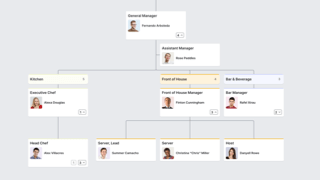Small Restaurant Org Chart Template
Need a hand building an org chart for your small restaurant? Our template includes the most common roles for essential dining room and kitchen staff, but you can tailor the roles to fit your business. We also have templates for large restaurants.
Build Your Org ChartReady to get started?
Download the Small Restaurant org chart template above, add your own employee data, and Import into Pingboard. Note: you’ll need a Pingboard account first. Sign up for a free trial.
Pro Tip You can build your org chart automatically. Instead of filling out a spreadsheet, you can connect your HR system to Pingboard to automatically sync employee data. Your org chart will get updated automatically every time a change happens. We integrate with ADP, Azure, BambooHR, Google Apps, Namely, Okta, and more.
Popular Restaurant Position Descriptions and Responsibilities
-
Restaurant Manager
The restaurant manager is typically responsible for hiring, training, and managing restaurant staff, with a focus on front-of-house personnel. Depending on the size of the restaurant, restaurant managers are sometimes also asked to drive marketing efforts and collaborate with the kitchen to develop menus. In many ways, the success of the restaurant rests on the shoulders of the restaurant manager because she will be responsible for handling customer complaints, ensuring sanitation and food quality, and generally overseeing the daily activities.
-
Executive Chef
The executive chef is accountable for all activities in the kitchen. They will hire everyone from the head chef to the dishwasher. Executive chefs will continually update menus for seasonality and evolving tastes. They will also need to train staff to create new dishes. In smaller restaurants, the task of ordering ingredients can sometimes fall on the Executive Chef, unless they delegate that task to their sous chef.
-
Kitchen Manager
Kitchen managers typically lead the kitchen staff and implement all the kitchen plans outlined by the executive chef. Kitchen managers also enforce all safety, hygienic, and food standards. The kitchen manager is typically the last person who sees the food before diners, so he is responsible for ensuring food quality and quality of the plating. The kitchen managers might also place ingredient orders, so he needs to have budgeting and outsourcing skills.
-
Sous Chef
The sous chef is a critical part of all kitchens because she is involved in the preparation of ingredients and main dishes. She needs to be a fast learner and be disciplined so that kitchen plans are followed meticulously. Sous chefs need to be able to work independently so whatever role they are filling in the kitchen can run smoothly. Finally, a sous chef is the eyes and ears of the kitchen—she will do inventory and status reports so that kitchen managers are aware of any potential issues.
-
Line Cook
Line Cooks are responsible for prep work in the kitchen and making sure that all kitchen stations are fully stocked before the kitchen opens. Line Cooks chop vegetables, prepare sauces, and make sure each station is cleaned to sanitary standards. They are usually assigned to a specific area in the kitchen, like the frier, salad prep, the grill, etc. Line cooks usually work under the kitchen manager and are considered an entry level position in the kitchen.
-
Servers
Servers are the face of a restaurant. They often seat customers, take orders, answer questions about the food, deliver the food to the table, and receive payment from the customers. Servers are expected to have upbeat personalities and strong memories so they can provide excellent customer service. They are also expected to set and clear tables and keep the front of the house clean.
Want more examples? Check out our templates for large restaurants and marketing agencies.
